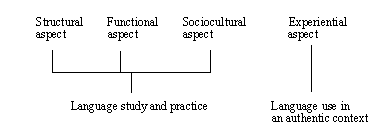10.3 Linguistic underpinning of syllabus design
A syllabus is an official document that authoritatively determines the content and principles of teaching and learning. It is designed with reference to: 1) the social aim for teaching the language; 2) information about the group of learners (their purpose, age, etc.); 3) the amount of time allocated in the curriculum; 4) theories of language and language acquisition. Linguistically, there are two fundamental questions in constructing a syllabus: what elements should be included? On what principle should they be sequenced?
Proponents of the structural syllabus assumed that the elements should be defined by reference to certain formal items of linguistic description and that the sentence should be the basic teaching unit. It was supposed that if learners could accumulate knowledge of the underlying system of the language, then they would be able to use the language in communication when occasions arise. The core component of a syllabus based on such theoretical assumptions is naturally sentence patterns, which are sequenced according to structural complexity (And the textbook along this line is full of pattern drills, with English 900 as a best example).
The structural syllabus has its advantage and defect. Its advantage is that it is, to some extent, economical. Learning a limited set of rules can lead to production of a very large number of sentences. Its serious defect lies in the fact that sentences are units of linguistic analysis but not of natural language use. Although learners may be able to construct grammatical sentences, they are often at a loss in real situations, wondering what is appropriate to say.
The principle for sequencing elements in a structural syllabus was also challenged when interlanguage studies gained insights into L2 acquisition. The assumed structural complexity, which was the basis for ordering elements, was not found to be well grounded. For example, the present progressive -ing appeared after the third person singular -s in a structural syllabus. But L2 acquisition research findings show that the former is acquired earlier than the latter. Due to these invalid assumptions, the structural syllabus tended to be abandoned in many parts of the world during the 1970s.
In the early 1970s, the theory of communicative competence was proposed by Dell Hymes. Functional linguists and pragmatists began to exert a stronger influence in the study of language. Since then communicative views of language teaching have been the foundation of syllabus design. The central question for proponents of a communicative syllabus was: “What does the learner need/want to do with the target language?” Syllabi began to appear in which content was specified, not only in terms of the grammatical elements, but also in terms of the functional items students would need to master in order to communicate successfully. The starting point in designing a communicative syllabus is the analysis of learners' needs. This kind of syllabus was first designed by European applied linguists, as represented by Van Ek (1975) and Wilkins (1976).
In a communicative syllabus, the objective of teaching a foreign language is developing learners' communicative competence. As communicative competence consists of grammatical competence, sociolinguistic competence, discourse competence and strategic competence, the syllabus is necessarily multidimensional. In the early 1980s, there were proposals to add functional aspect, sociocultural aspect and experiential aspect to the syllabus. Stern (1981) put forward a fourfold model as shown below:

Stern's model of a multidimensional syllabus
There have been other proposals and experiments in innovating syllabus design. What is meant here is not to illustrate all types of syllabus but to show that new insights and theories in linguistics will lead to changes in the practice of syllabus design.